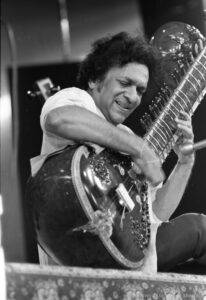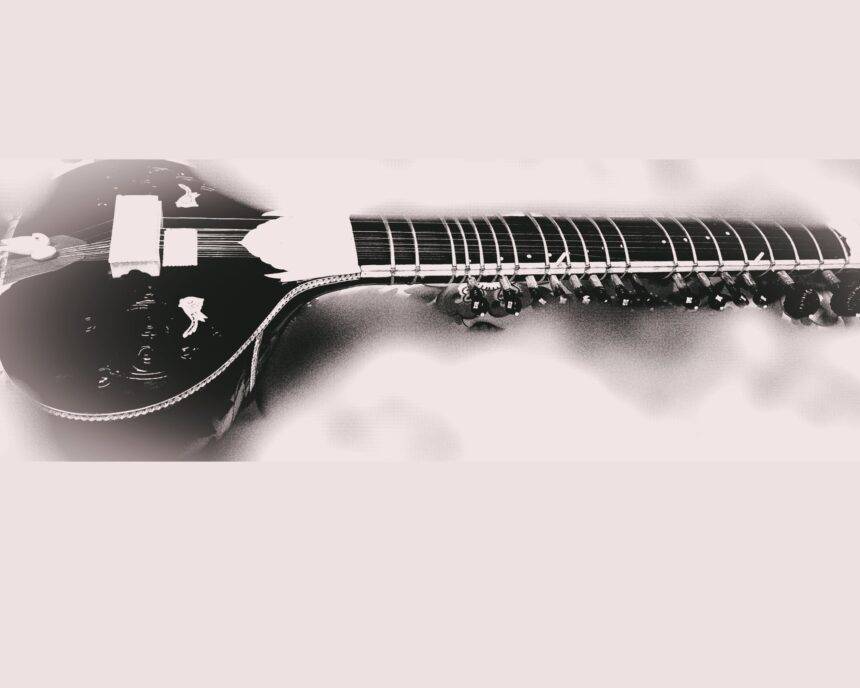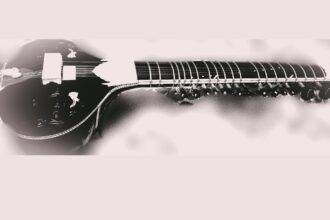In the previous section, the term “Kharaj Pancham” was mentioned in relation to the arrangement of the sitar strings. However, it is important to note that the Kharaj Pancham style encompasses much more than the string arrangement. Various Sitar-playing gharanas or traditions have their unique nuances when it comes to playing the Kharaj Pancham sitar. These nuances are based on certain elements that form the basis of the distinctiveness.
- The number of strings and their placement
- (The Guard) Tumba
- Outside decoration
- Juari
- The musical elements
As previously mentioned, the unique sound of the Kharaj Pancham sitar is attributed to its low-pitched Kharaj string. However, it is the arrangement of the sitar strings that set apart different performing gharanas. The string settings can be outlined as follows :
Number of Stings
Called as
Tuned to
01 Main String Madhyam (Ma)
02 Jodi Sadaj (Sa)
03 Jodi Sadaj (Sa)
04 Kharaj Khaaraj Pancham (Lower Octave Pa)
05 Pancham Pancham (Pa)
06 Chikari High Octave Sadaj (Sa)
07 Chikari One Octave Higer Sadaj than first chikari (Sa)
The arrangement of the strings described above is utilized by the Senia Jaipur gharana of sitar, which is considered to be the oldest tradition of sitar music. This gharana can trace its roots back to Masit Khan, who is credited with developing the sitar baaj or playing technique. Masit Khan’s contributions to sitar playing are an important topic that will be explored further, and readers may find that the various discussions are interconnected and build upon each other. While the intricacies of this subject may pose a challenge, readers who persevere and read on will begin to recognize the relationships between the various concepts. Referring to the string arrangement, the Maihar, Vishnupur, and Indore gharanas all add one Jodi and position the Kharaj (low-pitched) Sa note between the two Pancham strings on top of the basic setting described earlier. The other string settings remain the same.
All these arrangements of the Kharaj, its architectonics, etc are aimed to execute the dhrupad and veen techniques in sitar. Dhrupad, one of the oldest vocal genres in Indian classical music, has had a significant influence on the development of the sitar. The instrument was originally created in the 13th century as a modified veena designed to play dhrupad compositions. Over time, the sitar began to evolve and adapt to different styles and gharanas, and it eventually became a staple instrument in many forms of classical music. One of the key ways in which dhrupad influenced the sitar was through the use of meend, which is a gliding technique that involves bending the strings to produce a smooth and seamless transition between notes. This technique is prominently featured in dhrupad singing and was later adapted to the sitar, where it became an essential aspect of the instrument’s playing style.

Additionally, the use of alap in sitar playing, which involves exploring the melodic contours of a raga in a slow and deliberate manner, can be traced back to dhrupad. Pandit Ravi Shankar, in his biography talked about the need he felt in over use of the low-pitched Kharaj sting. His thrust for the dhrupad style of alap made him popularize the use of the Kharaj, which was earlier used by ustad Yusuf Ali Khan and Pandit Balram Pathak (Shankar, 1994).






